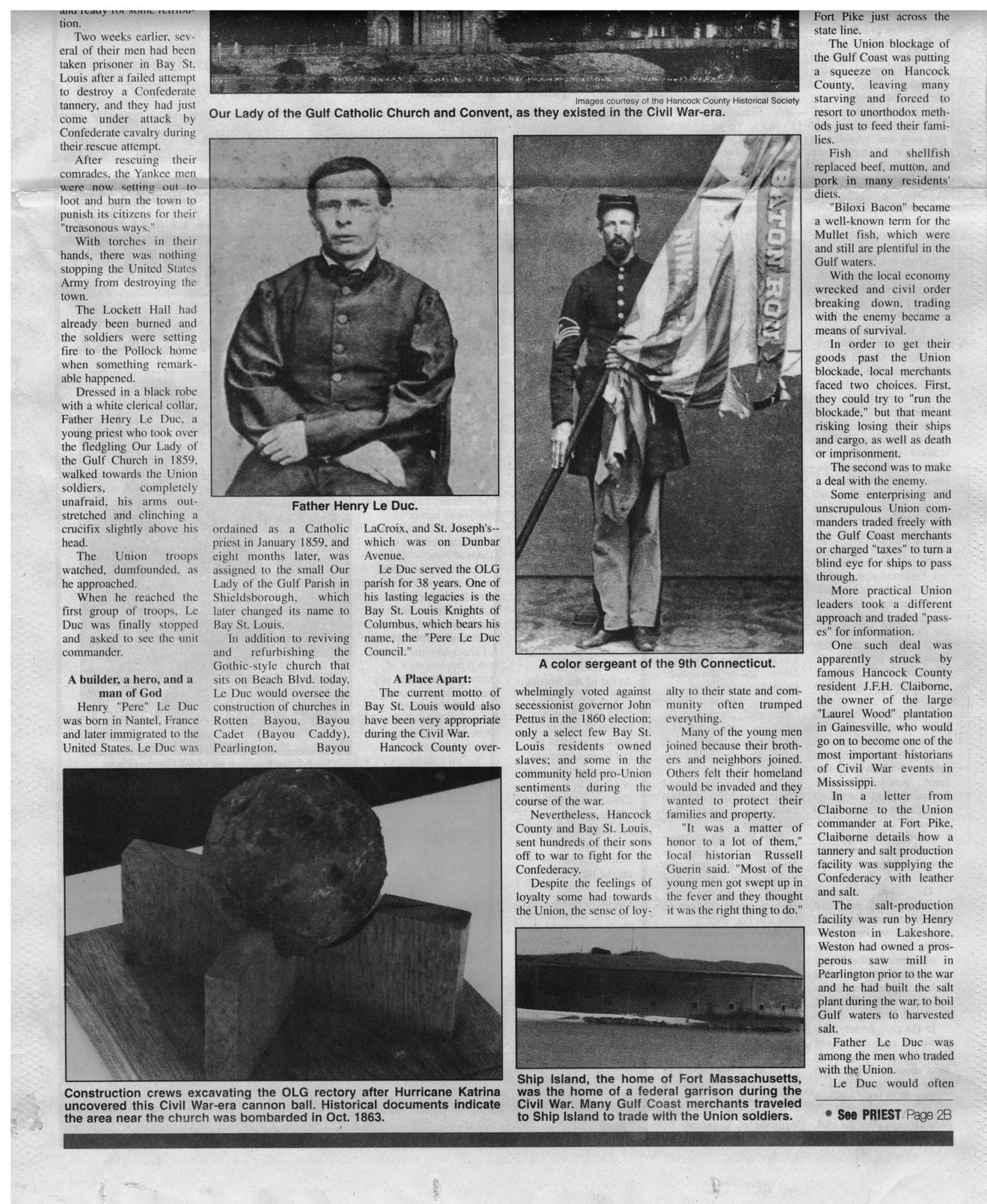This text was obtained via automated optical character recognition.
It has not been edited and may therefore contain several errors.
i ioouj ivn wiiit icuiutr tion. Two weeks earlier, several of their men had been taken prisoner in Bay St. Louis after a failed attempt to destroy a Confederate tannery, and they had just come under attack by Confederate cavalry during their rescue attempt. After rescuing their comrades, the Yankee men were now setting out to loot and burn the town to punish its citizcns for their "treasonous ways." With torches in their hands, there was nothing stopping the United States Army from destroying the town. The Lockett Hall had already been burned and the soldiers were setting fire to the Pollock home when something remarkable happened. Dressed in a black robe with a white clerical collar. Father Henry Le Due. a young priest who took over the fledgling Our Lady of the Gulf Church in 1859, walked towards the Union soldiers, completely unafraid, his arms outstretched and clinching a crucifix slightly above his head. The Union troops watched, dumfounded. as he approached. When he reached the first group of troops. Le Due was finally stopped and asked to see the unit commander. A builder, a hero, and a man of God Henry "Pere" Le Due was born in Nantel. France and later immigrated to the United States. Le Due was ■ TT-; Images courtesy of the Hancock County Historical Society Our Lady of the Gulf Catholic Church and Convent, as they existed in the Civil War-era. Father Henry Le Due. ordained as a Catholic priest in January 1859, and eight months later, was assigned to the small Our Lady of the Gulf Parish in Shieldsborough. which later changed its name to Bay St. Louis. In addition to reviving and refurbishing the Gothic-style church that sits on Bcach Blvd. today. Le Due would oversee the construction of churches in Rotten Bayou. Bayou Cadet (Bayou Caddy), Pearlington. Bayou LaCroix. and St. Joseph's-which was on Dunbar Avenue. Le Due served the OLG parish for 38 years. One of his lasting legacies is the Bay St. Louis Knights of Columbus, which bears his name, the "Pere Le Due Council." A Place Apart: The currcnt motto of Bay St. Louis would also have been very appropriate during the Civil War. Hancock County over- A color sergeant of the 9th Connecticut. whelmingly voted against secessionist governor John Pettus in the I860 election: only a select few Bay St. Louis residents owned slaves; and some in the community held pro-Union sentiments during the course of the war. Nevertheless, Hancock County and Bay St. Louis, sent hundreds of their sons off to war to fight for the Confederacy. Despite the feelings of loyalty some had towards the Union, the sense of loy- alty to their state and community often trumped everything. Many of the young men joined because their brothers and neighbors joined. Others felt their homeland would be invaded and they wanted to protect their families and property. "It was a matter of honor to a lot of them," local historian Russell Guerin said. "Most of the young men got swept up in the fever and they thought it was the right thing to do." Construction crews excavating the OLG rectory after Hurricane Katrina uncovered this Civil War-era cannon ball. Historical documents indicate the area near the church was bombarded in Oct. 1863. Ship Island, the home of Fort Massachusetts, was the home of a federal garrison during the Civil War. Many Gulf Coast merchants traveled to Ship Island to trade with the Union soldiers. Fort Pike just across the state line. The Union blockage of the Gulf Coast was putting a squeeze on Hancock County, leaving many starving and forced to resort to unorthodox methods just to feed their families. Fish and shellfish replaced beef, mutton, and pork in many residents' diets. "Biloxi Bacon” became a well-known term for the Mullet fish, which were and still are plentiful in the Gulf waters. With the local economy wrecked and civil order breaking down, trading with the enemy became a means of survival. In order to get their goods past the Union blockade, local merchants faced two choices. First, they could try to "run the blockade." but that meant risking losing their ships and cargo, as well as death or imprisonment. The second was to make a deal with the enemy. Some enterprising and unscrupulous Union commanders traded freely with the Gulf Coast merchants or charged "taxes" to turn a blind eye for ships to pass through. More practical Union leaders took a different approach and traded "passes" for information. One such deal was apparently struck by famous Hancock County resident J.F.H. Claiborne, the owner of the large "Laurel Wood" plantation in Gainesville, who would go on to become one of the most important historians of Civil War events in Mississippi. In a letter from Claiborne to the Union commander at Fort Pike. Claiborne details how a tannery and salt production facility was supplying the Confederacy with leather and salt. The salt-production facility was run by Henry Weston in Lakeshore. Weston had owned a prosperous saw mill in Pearlington prior to the war and he had built the salt plant during the war. to boil Gulf waters to harvested salt. Father Le Due was among the men who traded with the Union. Le Due would often • See PRIEST Page 2B

Our Lady of the Gulf Church Document (169)